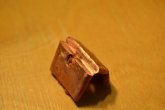Haugen, you mentioned galvanic corrosion if you use solder. Is it really that important? (in marine environs probably but if not?) Also: I know solder makes copper more brittle (that is why NASA does not solder and recommends crimping), but again this may not be an issue with a thick braided wire like this?
To be clear, I misunderstood the process that was being used, and there is no soldering on the bus bars being discussed here.
On to the techie stuff...
Yes, galvanic corrosion is a real threat.
The fact that many of these systems are meant to be used in RVs, boats, and other outdoor gear and has a life expectancy measured in years and maybe decades, corrosion will definitely play a part at some point. Add dissimilar metals to the mix, and it accelerates the process.
Of course, there is maintenance and preventative measures, but I don't know if anyone plans to remove the steel bolts from their aluminum terminals to inspect them for corrosion. I wouldn't bet on it.
When it comes to solder, it is generally tin and lead which will corrode before the copper. Do a search for "F-16 fighter crash MIL-L-87177A" and let Scott Dotson teach you about how costly corrosion on electronics can be, even in a "sealed" connector.
When you talk about embrittlement, the aerospace industry is more concerned with soldering gold plated pins. This practice, not only adds additional metals to the connection for corrosion consideration, but the gold melts and combines with the solder making it brittle. There is also the topic of tin whiskers, but that doesn't really apply here.



